Glass of the Second Half of the 19th Century
The early years of the second half of the 19th century in western Europe (and especially in England) were marked by a reform movement that strove to elevate the aesthetic level of craftsmanship. This movement turned to Historical Styles for inspiration. Glass engravers who had left Bohemia and settled in the British Isles were highly instrumental in introducing new glass-decorating methods. In central Europe, Ludwig Lobmeyr (1829–1917) had a prominent place in glass production. From the 1860s, he specialized in exquisite glass made in the Renaissance and Baroque Revival styles. In the 1870s, he expanded his glass output to include oriental patterns. In Italy, Antonio Salviati (1816–1890) strove to revive the traditional Venetian art of glassmaking. In France, the world-renowned glass artist and technologist Emile Gallé (1846–1904) was professionally active in Nancy. The 19th century saw the flourishing of a new production method – pressed, or rather mould-pressed, glass. The foremost producers of this type of glass were based in the United States. The principal companies that utilized this method of glass decoration in Europe were centred in France (Cristalleries de Baccarat) and England (e.g. glass companies in Birmingham and Stourbridge). Owing to the relatively cheap yet highly-qualified manual labour, this technology was also adopted in the Czech lands at the end of the 19th century.Glass of the Second Half of the 19th Century (Historical Styles)
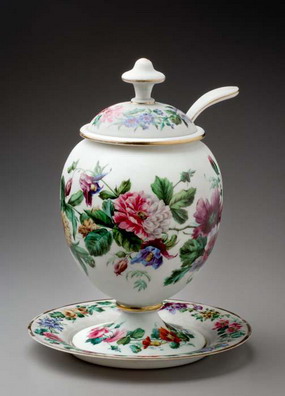
Punch bowl
Bohemia, c. 1875
Milk glass, painted, gilded; bowl H. 26.5 cm, tray diameter 28 cm, spoon L. 31 cm
Inv. no. 77?524 abc
Acquired in 1963 by ownership transfer
JSch
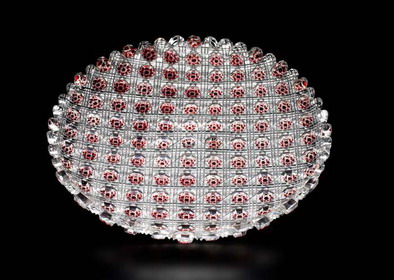
Plate
England, Thomas Webb & Sons London, 1878
Colourless flint glass, red-stained, cut; diameter 24 cm
Inv. no. 153
Purchased in 1878, Paris
The dish was purchased at the World’s Fair in Paris in 1878 for the collections of the future Museum of Decorative Arts in Prague. Vojtěch Lanna was the initiator of this and other acquisitions.
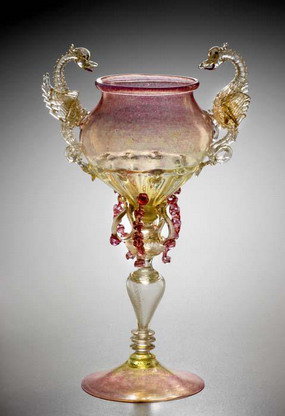
Goblet
Italy, Venice, V. Zuffe and Co. glassworks, c. 1890
Colourless glass, decorated with gold and pink aventurine, hot-shaped; H. 34 cm
Inv. no. 75?008
Purchased in 1971 from an antique shop, Prague
The glass collection of the National Museum in Prague (originally in the Náprstek Museum) holds a large number of glass objects produced by the V. Zuffe glassworks in Murano. The ensemble was donated to the museum in 1901 by Josef Pinkava, a prominent Prague entrepreneur who also sold Art Nouveau glass from Klá?tersky Mlyn (Klostermühle).

Lamp
France, Imberton, Paris, c. 1880
Colourless glass, hot-shaped, painted in enamels; H. 33 cm, diameter 21 cm
Inv. no. 2 074
Purchased in 1887
A copy of an original 13th-century lamp housed in a mosque in Cairo, Egypt.
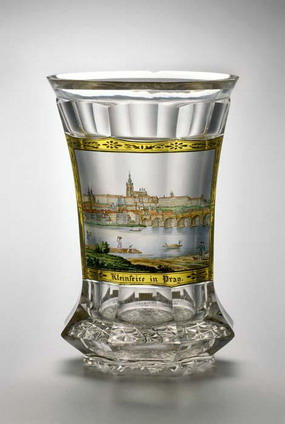
Beaker with a view of Prague Castle and the Lesser Town (Malá Strana)
Bohemia, 2nd quarter of 19th century
Colourless glass, cut, painted in transparent colours; H. 12.4 cm
Inscription: Kleinseite in Prag
Inv. no. 79?921
Acquired in 1963 by ownership transfer
HB
114
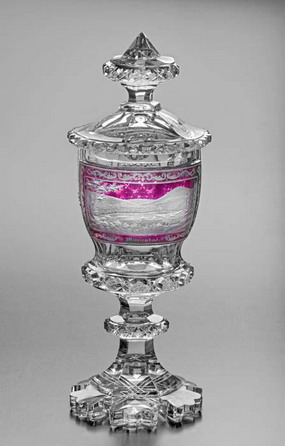
Bohemia, 1845
Colourless glass, partially rosaline-stained, cut (Neuwelt), engraved (Western Bohemia), H. 35 cm
Inv. no. 45?443
Purchased in 1958 from Artia, Prague
The goblet with a view of Mariensbad has an inscription on the lid that reads: “od Ant. V. Lebedi w roku 1845” (“by Ant. V. Lebedi in 1845”). It refers to Antonín Vincenc Lebeda (1795–1857), a prominent Prague manufacturer of hunting and sport shooting firearms of the first half of the 19th century. The goblet could have been a gift for one of Lebeda’s leading trade partners.
HB
Reverse painting with Our Lady of P?tsch
Eastern Bohemia, Kun?tát (Kronstadt), Workshop of Daniel and Ignaz Preissler, c. 1700
Painted in black and opaque colours, and gold leaf on the reverse side (gilt-wood frame); 24.5 x 18.5 cm (with frame 27.5 x 21.5 cm)
Inv. no. 18?187
Donated in 1932 by Gustav E. Pazaurek, Stuttgart
This reverse painting is a reproduction of one of the famous paintings of the Virgin Mary dated to the late 17th century. Termed Rosa mystica by Empress Eleonore Magdalene, the wife of Emperor Leopold I, the picture is still found on an altar in the southwest corner of the nave of St. Stephen’s Cathedral in Vienna. Originally housed in a Roman Catholic church in P?tsch in Upper Hungary (now Ukraine), according to legend, between February 4 and December 8, 1696, the Madonna in the picture shed real tears. Two miraculous incidencts and healings are said to have followed. In 1697, Emperor Leopold had the painting transferred to Vienna to ensure the patronage and protection of the city and the Empire and to assist him in the struggle against the Turkish enemy.
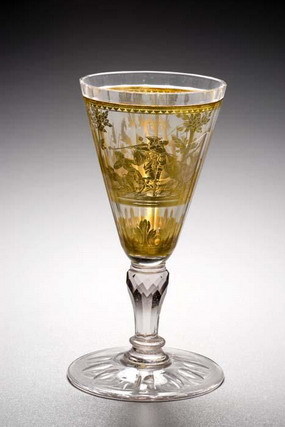
Goblet with a hunting scene
Northern Bohemia, decorated in a workshop on the Harrach estate, c. 1730–1740
Colourless glass, double-walled, cut, engraved in gold leaf; H. 14.5 cm
Inv. no. 8?868
Purchased in 1904 from E. Genzinger
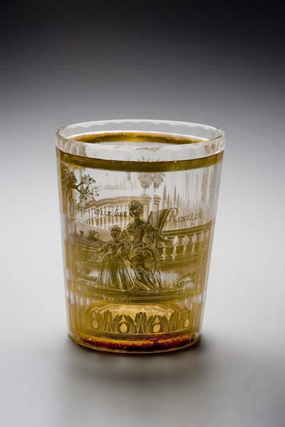
Beaker with a portrait of Jakub Hapergl’s family
Northern Bohemia, decorated in a workshop on the Harrach estate, c. 1730–1740
Colourless glass, double-walled, cut, engraved in gold leaf; H. 8.8 cm
Inscription: Jacobus Hapergl. VIVAT. Ville Jare, ROSALIA, WABEDEL, THERESIE.
Inv. no. 13?197
Purchased in 1913 from Alois Pot??ek, Prague
Although Jakub Hapergl remains unidentified, he may be credited with introducing the viewer to this middle-class family scene. According to the inscription, this is a celebration of an important occasion in the life of a family member, probably the birthday of the wife Rosalie, which is set against garden architecture.
Glass of the Renaissance Period
Around the mid-15th century, the first objects in the millefiori and vetro a filigrana (glass with threads) techniques were made in Venice, Italy. These methods of decorating glass enjoyed the greatest popularity in the 16th and 17th centuries. Hot-formed glass, optical decoration and crackle glass were some of the glass-refining processes of this period. With the emigration of glass masters from Venice, glass made in imitation of Venetian products (fa?on de Venise) spread throughout western and central Europe. In the last third of the 17th century, glass cutting and engraving was revived in central Europe. Caspar Lehmann (1563– or 1564–1622), a court glass and gemstone engraver, was employed at the Prague Court of Emperor Rudolf II (The House of Habsburg). Apart from carved glass, glass-decorating techniques of the Renaissance included diamond-point engraving (Venice, Catalonia, Central Europe), enamel painting (Venice, Central Europe), cold decoration – with surfaces painted in oils and mastic (Central Europe) and, of course, decoration of glass while hot. Underpainted glass (reverse painting on glass sheets) was another popular cold-working technique.
Enamel-Painted Venetian and Northern Glass of the Renaissance Period
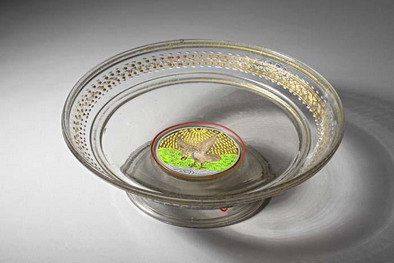
Footed bowl
Italy, Venice, 1st half of 16th century
Colourless glass, enamel and gold painted; diameter 20.5 cm
Inv. no. 79?094
Acquired in 1963
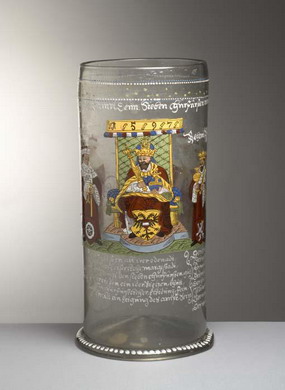
Beaker depicting the Emperor and Electors of the Holy Roman Empire
Bohemia, 1597
Light green glass, painted with coloured enamels; H. 26 cm
Inv. no. 9?883
Donated in 1906 by Vojtěch Lanna, Prague
This beaker (Humpen in German) featuring an image of the Emperor (Rudolf II) surrounded by electors shows a widely popular theme that frequently appeared on Renaissance glass in central Europe. Its decoration was inspired by an illustration from the famous Liber chronicarum authored by Hartmann Schedel (Nuremberg 1493), a chronicle of the then-known world, written from a European’s perspective. The chronicle holds the earliest representation of Prague (fol. 229–230). These and other similar beakers – one painted with the Imperial Eagle and another with an elector on horseback – propagated and symbolized the unity of central European countries, while also expressing the loyalty of the vessel’s owner to the ruling House of Habsburg.
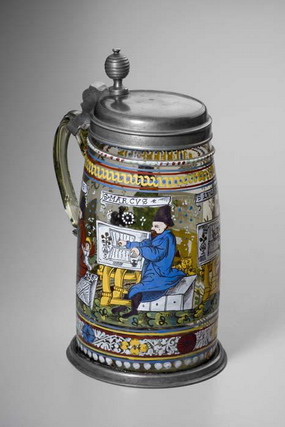
Humpen showing the Four Evangelists
Bohemia, 1610
Light green glass, painted in enamels, tin; H. 21.5 cm
Inv. no. 9?953
Donated in 1906 by Vojtěch Lanna, Prague
Depicted on the surface of this conical, slightly bulbous tankard with a tin lid and a tin-mounted base, between friezes of braids and plant ornament, are the Four Evangelists – Matthew, Luke, Mark and John, seated on benches and writing the Gospels, the essential writings of the New Testament.
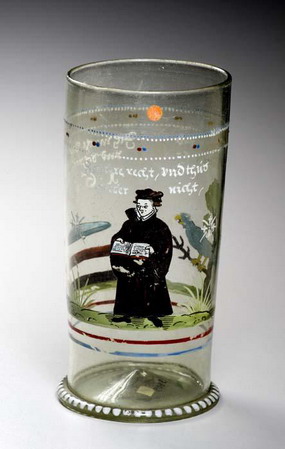
Humpen with the figures of a priest, cuckoo and whetstone
Bohemia or Germany, 1608
Colourless glass, painted in enamels; H. 18 cm
Inv. no. 9?909
Donated in 1906 by Vojtěch Lanna, Prague
HB
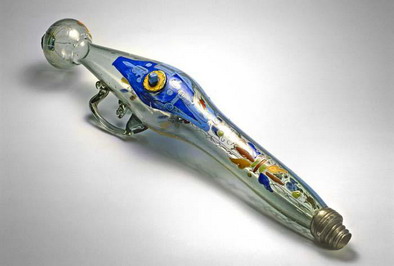
Pistol-shaped bottle
Bohemia, 17th century
Colourless glass, hot-shaped, painted in enamels, tin mounting; L. 40 cm
Inv. no. 9?963
Donated in 1906 by Vojtěch Lanna, Prague
This flask in the form of a pistol is a faithful rendering of a 16th-century novelty – a firearm fitted with a wheel-lock mechanism. These vessels, often also made of coloured glass and undecorated, were produced in Bohemia until the 18th century.
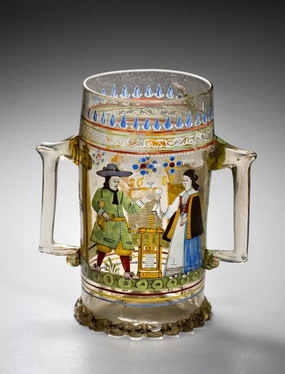
Humpen with two handles
Bohemia, Fichtelberg in the Ore Mountains, 1687
Light green glass, painted in enamels; H. 20.5 cm
Inv. no. 52?202
Purchased in 1961 from a Klenoty shop, Prague
HB
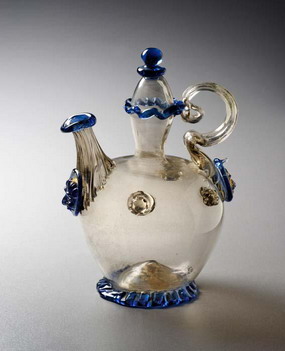
Pitcher
Spain, Catalonia, end of 16th century–beginning of 17th century
Colourless and blue glass, hot-shaped; H. 12.5 cm
Inv. no. 9?781
Donated in 1906 by Vojtěch Lanna
HB
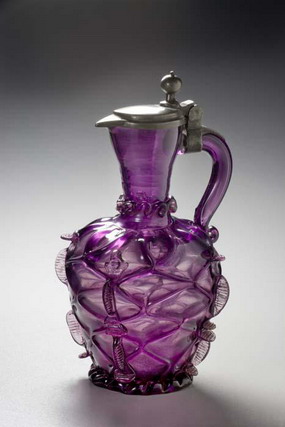
Jug
England, London, George Ravenscroft, end of 1670s
Purple (manganese) glass, hot-shaped, tin mounting; H. 17.5 cm
Inv. no. 10?396
Donated in 1906 by Vojtěch Lanna
After an extended stay in Venice, where lead glass was employed for coloured glass imitations of semi-precious stones, George Ravenscroft (1632–1683) developed a production technique facilitating the use of lead glass for the production of hollowware. The UPM’s glass collection houses a jug of the same form and decoration, originally in the Vojtěch Lanna collection, executed in superb crystal (lead) glass. This object clearly echoes the influence of late fa?on de Venise glass made in western Europe and of Venetian glass proper.
The exhibition of European glass art treasures unveiled at Henan Museum on Mar. 26, 2015. All these masterpieces of glass came from Bragg National Art Museum of the Czech Republic.
All of 211 pieces of glass showed in Henan Museum came from the beginning of twentieth Century of Ancient European. The central plains people can enjoy the art miracle in recent 2000 years.
This Chinese Tour is a cultural exchange between Czech and China great event. It is also the first large-scale exhibition in the Far East Area of Bragg National Art Museum. The glass wares exhibited this time were selected from ancient, medieval to modern and all important periods.
The exhibition will last to jun. 14, 2015.